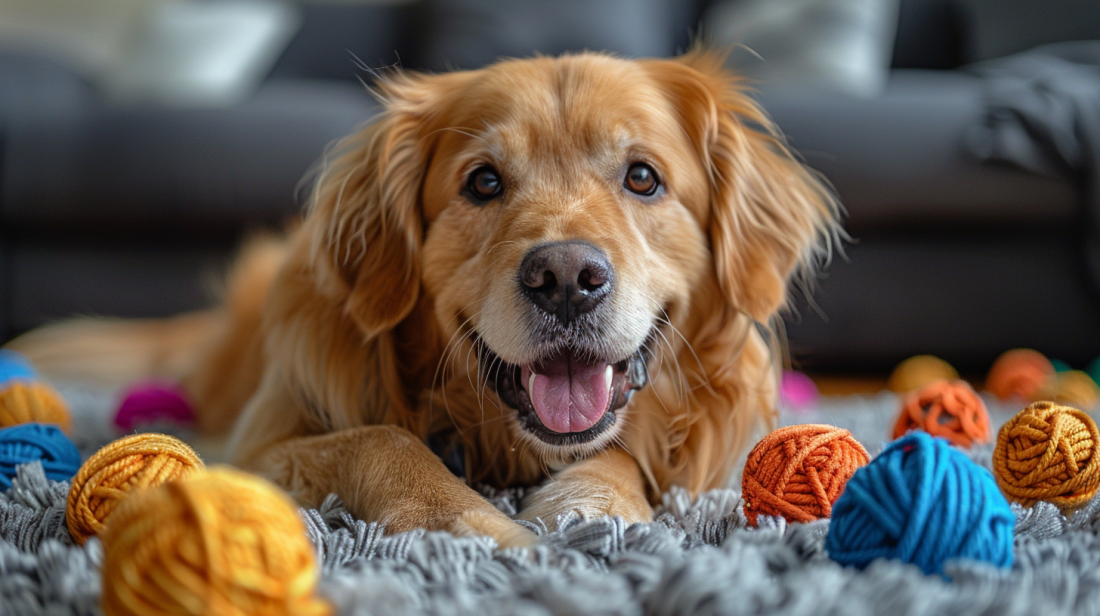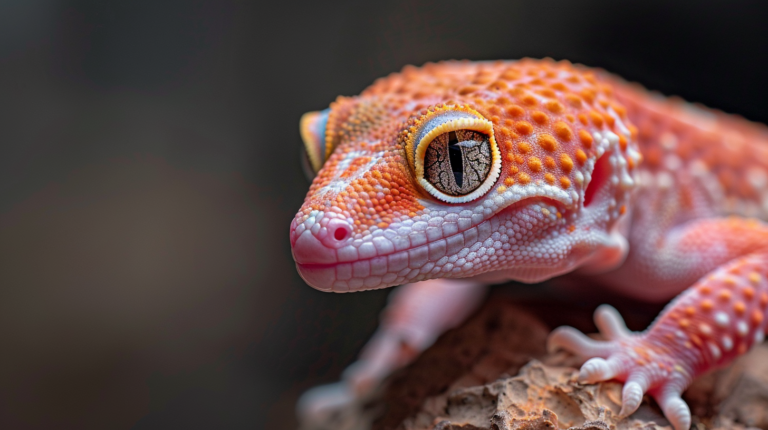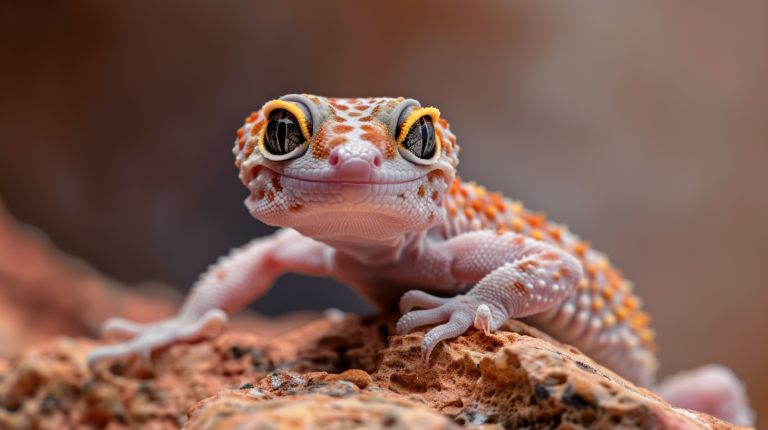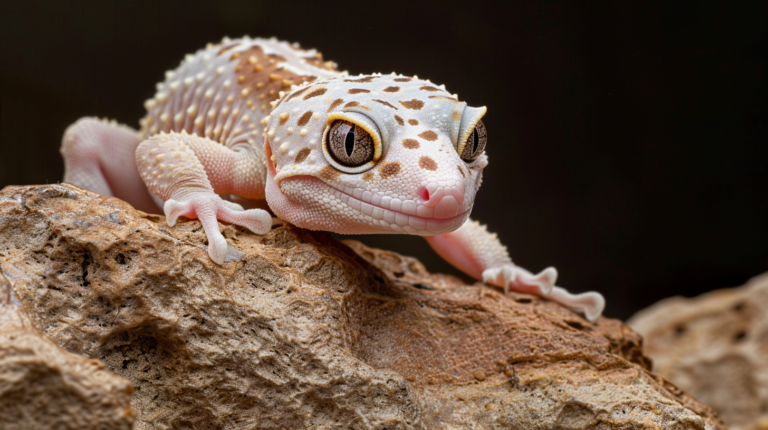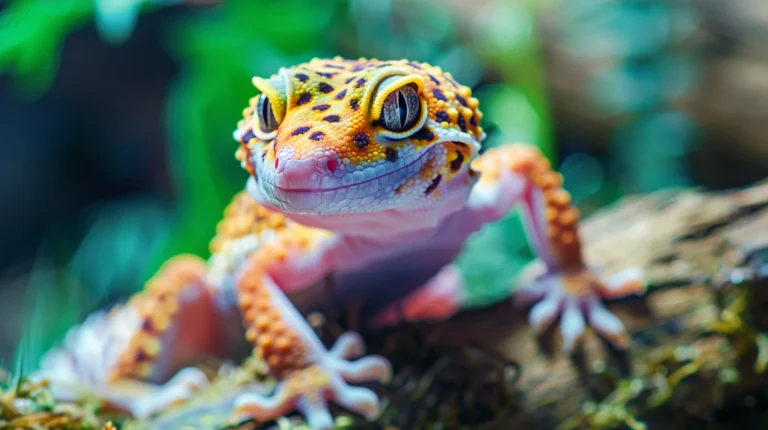Discover 5 easy DIY dog toys you can make in just 10 minutes using household items. Save money while providing safe, engaging playtime for your furry friend!
Table of Contents
Introduction: Why DIY Dog Toys Make Sense
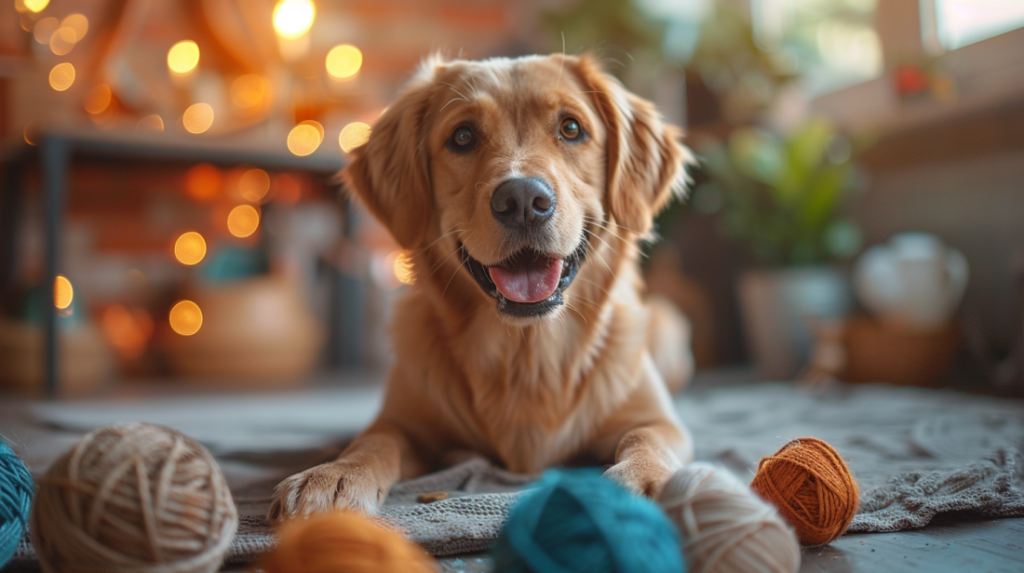
Does your furry friend destroy store-bought toys faster than you can replace them? Are you tired of spending a small fortune on playthings that last mere minutes? You’re not alone. The average American dog owner spends between $40-$75 annually on dog toys, according to the American Pet Products Association’s 2023 survey—yet many report their pets lose interest quickly or destroy these items within days.
Crafting DIY dog toys at home offers a practical, economical alternative that benefits both you and your canine companion. Not only can you save money, but you can also customize toys to match your dog’s specific play style, size, and preferences. Plus, there’s something undeniably satisfying about watching your pup enjoy something you’ve created specifically for them.
In this comprehensive guide, we’ll explore five quick and easy DIY dog toys you can create in just 10 minutes or less using everyday household items. These projects require minimal crafting skills and materials you likely already have on hand. Beyond the step-by-step instructions, we’ll discuss the benefits of each toy type, safety considerations, and creative variations to keep your pet engaged for hours.
Whether you’re a crafting enthusiast looking for your next project or simply a budget-conscious pet parent seeking alternatives to expensive pet store options, these homemade dog toys will provide both mental stimulation and physical exercise for your four-legged family member.
The Benefits of Making Your Own Dog Toys
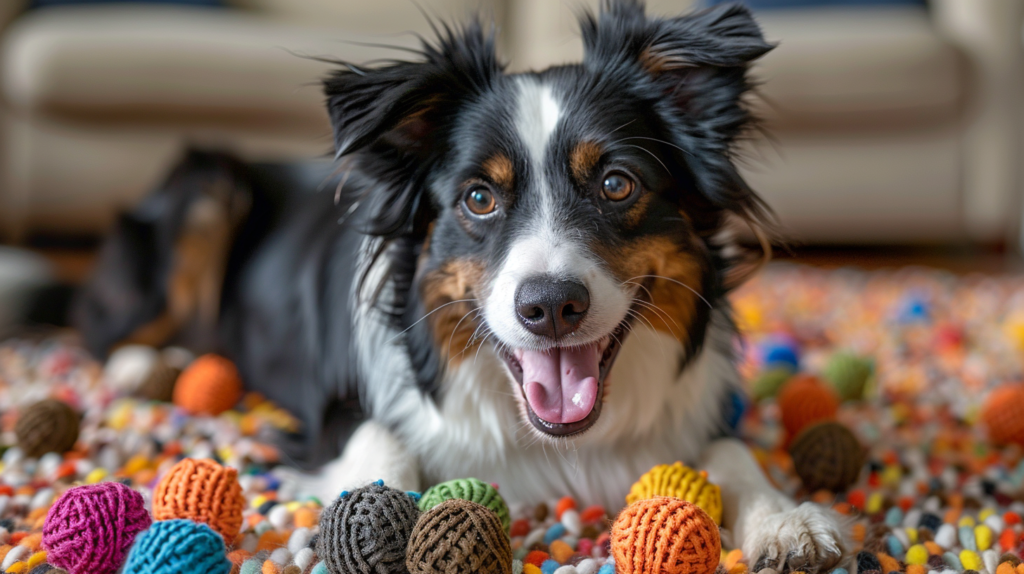
Before diving into our DIY projects, let’s explore why creating homemade toys benefits both you and your canine companion:
Cost-Effective Entertainment
Commercial dog toys can quickly strain your pet care budget. According to veterinary behaviorist Dr. Karen Becker, “Many pet owners don’t realize that the most engaging toys are often the simplest and least expensive.” By repurposing items around your home, you can create engaging playthings at a fraction of retail prices.
Environmental Sustainability
Creating toys from upcycled materials reduces waste and your carbon footprint. The pet industry produces significant plastic waste through packaging and products; DIY alternatives help minimize this environmental impact.
Customization for Your Dog’s Needs
Every dog has unique preferences and play styles. Some enjoy puzzle toys that challenge their problem-solving skills, while others prefer toys they can fetch or tug. Homemade options allow customization based on:
- Size and breed requirements
- Chewing intensity
- Play preferences
- Specific enrichment needs
Strengthening Your Bond
The time invested in creating something specifically for your pet strengthens your relationship. According to certified dog trainer Emma Johnson, “Dogs can sense when something has your scent and attention invested in it, often making homemade toys more appealing than store-bought alternatives.”
Reducing Exposure to Harmful Chemicals
Some commercial toys contain plastics, dyes, or preservatives that may be harmful. Crafting toys yourself means controlling exactly what materials come in contact with your pet.
Safety Considerations for DIY Dog Toys
Before we get started with our DIY projects, let’s address some important safety considerations:
- Know your dog’s chewing style: Power chewers need more durable materials and closer supervision.
- Size appropriately: Toys should be large enough that they can’t be swallowed or cause choking.
- Remove hazardous components: No small parts, buttons, or items that could be easily detached and ingested.
- Use pet-safe materials: Avoid toxic glues, paints, or materials treated with chemicals.
- Regular inspection: Check homemade toys frequently for wear and tear, discarding them when they become damaged.
- Supervised play: Always monitor your dog with any new toy until you’re confident in its safety.
Dr. Michael Thompson, DVM, emphasizes: “The right toy for your dog depends on their size, age, and chewing habits. What works for one dog may be dangerous for another. Always supervise play with new toys initially.”
Now, let’s dive into our 5 quick and easy DIY dog toys you can make in just 10 minutes!
1. The No-Sew T-Shirt Rope Toy
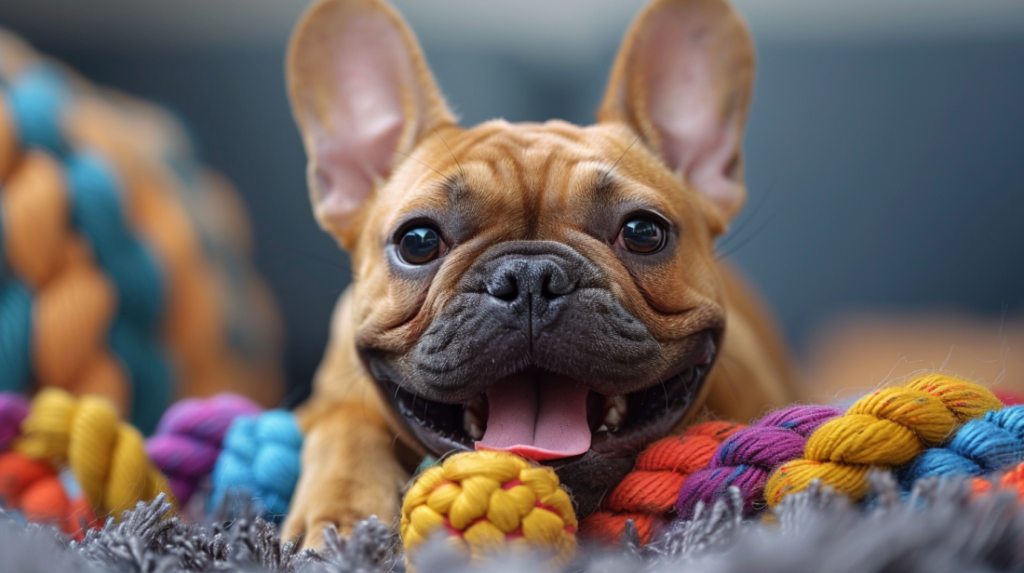
Materials Needed:
- 1-2 old t-shirts (100% cotton works best)
- Scissors
Time Required:
5-7 minutes
Instructions:
- Prepare the t-shirt:
- Lay your t-shirt flat on a clean surface
- Cut off the bottom hem and the sleeves
- Cut the remaining shirt into 3-inch horizontal strips from bottom to armpit
- Create your rope:
- Stretch each strip to create yarn-like strands (this helps them curl)
- Gather 6-9 strands and tie them together at one end with a tight knot
- Separate strands into three equal sections
- Braid the sections tightly
- Secure the end with another tight knot
- Finishing touches:
- Trim any loose or uneven ends
- Tug on the braid to test its strength
Why Dogs Love It:
This rope toy appeals to dogs who enjoy tugging games and provides an excellent outlet for chewing instincts. The natural cotton material is gentle on teeth and gums while still offering resistance that satisfies the urge to chew.
Variations:
- Multi-colored design: Use t-shirts of different colors for a rainbow effect
- Scented version: Add a drop of pet-safe essential oil like lavender (for calming) or mint (for freshness)
- Size adjustments: Use more or fewer strips for dogs of different sizes
- Addition of tennis ball: Tie a braid around a tennis ball for a tug-and-fetch combination
According to a 2023 study in the Journal of Veterinary Behavior, tug toys like this one can actually strengthen the human-animal bond when used correctly—providing both physical exercise and positive interaction.
Expert Tip:
“For dogs who love to shake and ‘kill’ their toys, t-shirt rope toys are ideal because they’re lightweight enough for vigorous play but durable enough to withstand repeated use,” notes certified dog behaviorist Samantha Turner.
2. The Water Bottle Crinkle Toy
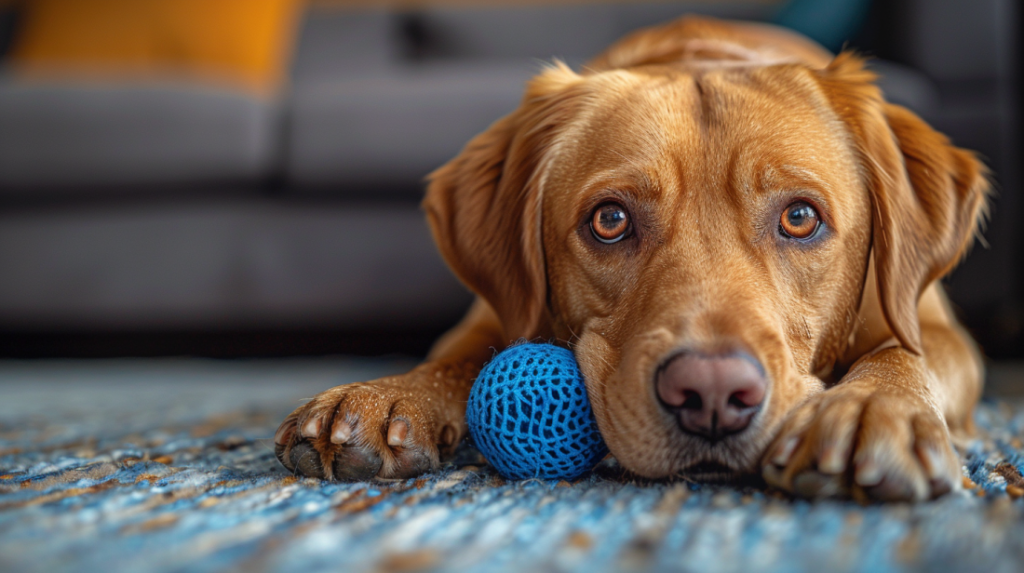
Materials Needed:
- Empty plastic water bottle (remove label, cap, and plastic ring)
- Old sock, washcloth, or small towel
- Scissors
- Optional: needle and thread (for more durability)
Time Required:
3-5 minutes
Instructions:
- Prepare the bottle:
- Remove the cap, label, and plastic ring from the bottle
- Squeeze out excess air and slightly crush the bottle to make it more pliable
- Ensure there are no sharp edges
- Create the cover:
- Take an old sock (crew length works best)
- Insert the bottle into the sock
- Tie a knot at the open end, or for added security, stitch it closed
- For washcloth/towel version: wrap the bottle in fabric and secure with tight knots on both ends
- Safety check:
- Ensure all parts are securely contained
- Test the toy by squeezing it firmly to make sure no plastic pieces can escape
Why Dogs Love It:
The crinkling sound of the plastic bottle mimics the sound of prey animals in nature, triggering your dog’s natural hunting instincts. The unpredictable noises provide mental stimulation, while the texture offers a satisfying mouthfeel.
A survey conducted by BlithePet in 2023 found that 78% of dogs showed immediate interest in crinkle toys, with small-to-medium breeds showing particular enthusiasm.
Variations:
- Freezable option: Use a flexible water bottle that can be partially filled with water and frozen for teething puppies
- Extra sensory appeal: Add a tennis ball inside a larger sock alongside the bottle
- Enhanced texture: Use a ribbed or textured sock for additional tactile stimulation
- Training tool: Reserve this high-value toy for positive reinforcement during training sessions
Expert Tip:
Veterinary behaviorist Dr. Rebecca Liu cautions: “While crinkle toys are generally safe, they’re not appropriate for aggressive chewers who might tear through the fabric covering and ingest plastic pieces. Always supervise play with this type of toy.”
3. The Muffin Tin Treat Puzzle
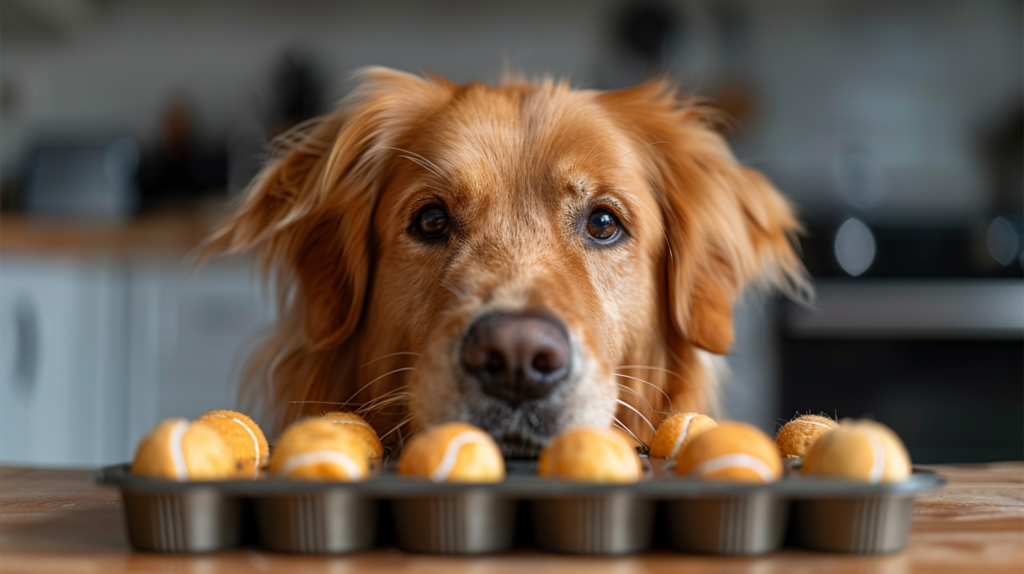
Materials Needed:
- Standard 12-cup muffin tin
- 12 tennis balls (or appropriate-sized balls for your tin)
- Dog treats or kibble
Time Required:
2-3 minutes
Instructions:
- Set up the puzzle:
- Place the muffin tin on a flat surface
- Put small treats or pieces of kibble in some or all of the cups
- Cover each cup with a tennis ball
- Introduce to your dog:
- Show your dog one of the treats being placed in the tin
- Demonstrate how to move a ball to reveal the hidden treasure
- Encourage investigation with enthusiastic praise
Why Dogs Love It:
This interactive puzzle toy engages your dog’s problem-solving abilities and rewards their persistence. According to canine cognition specialist Dr. Brian Hare, “Dogs naturally enjoy working for their food. It’s mentally stimulating and satisfies their foraging instincts.”
Research published in Applied Animal Behaviour Science indicates that puzzle toys like this can reduce boredom-related behavior problems by up to 30% when used regularly.
Variations:
- Progressive difficulty: Start with treats in all cups, then gradually reduce to make the game more challenging
- Sensory enhancement: Use balls of different textures or sizes
- Alternative containers: Substitute with a shallow cardboard box and toilet paper tubes cut in half
- Scent challenge: Rub different herbs on various balls to add an olfactory dimension
Expert Tip:
“This type of food puzzle is perfect for dogs who gulp their meals too quickly,” says veterinary nutritionist Dr. Sarah Mitchell. “It slows down their eating while providing mental exercise, which can help prevent digestive issues like bloat in susceptible breeds.”
4. The Braided Fleece Tug Toy
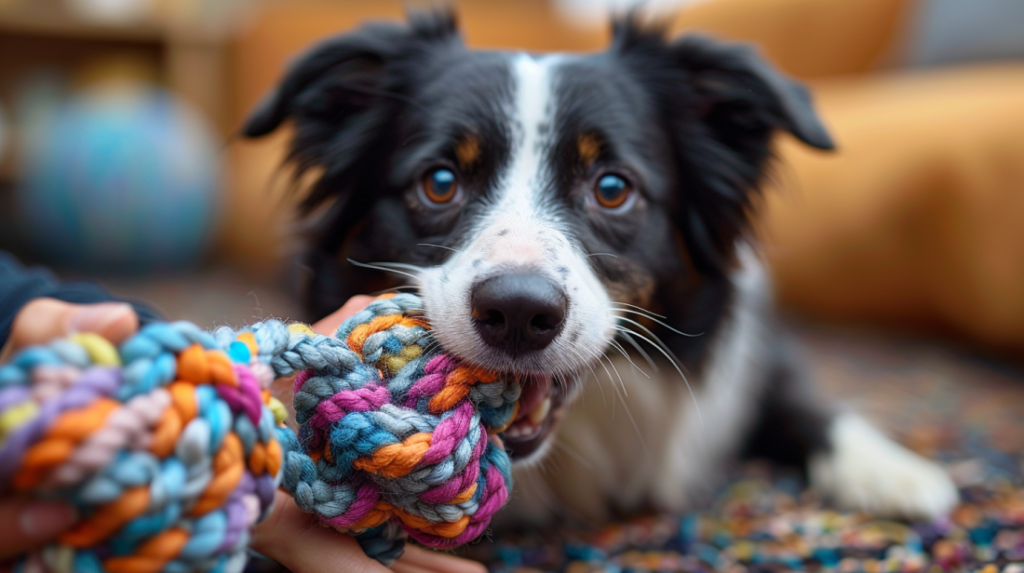
Materials Needed:
- Fleece fabric scraps (no-pill fleece works best)
- Scissors
Time Required:
8-10 minutes
Instructions:
- Prepare the fleece strips:
- Cut fleece into 3 strips, each about 3 inches wide and 3 feet long
- For larger dogs, make strips wider and longer
- For smaller dogs, adjust proportionally smaller
- Create your tug toy:
- Lay the three strips on top of each other
- Tie a tight overhand knot at one end, leaving about 2 inches of fringe
- Separate the three strips and braid them tightly
- When you reach the end, tie another tight overhand knot
- Trim the ends if necessary for a neat appearance
Why Dogs Love It:
Fleece provides the perfect combination of softness and durability for interactive play. The material is gentle on teeth and gums but strong enough to withstand tugging games. Plus, the bright colors are visually stimulating for your canine companion.
The American Kennel Club notes that appropriate tug toys like this one can actually help teach bite inhibition and impulse control when used with consistent rules during play.
Variations:
- Texture mixing: Incorporate different fabric types for sensory variety
- Kong attachment: Braid around a Kong toy for added interest
- Scented version: Sprinkle with pet-safe essential oils or hide small treats in the braid
- Handling loop: Create a hand loop at one end for easier grip during tug games
Expert Tip:
Professional dog trainer Carlos Mendez recommends: “Use your fleece tug toy for structured play sessions with clear beginning and end signals. This helps your dog understand when it’s appropriate to engage in rougher play and when it’s time to calm down.”
5. The Sock-Covered Tennis Ball Launcher
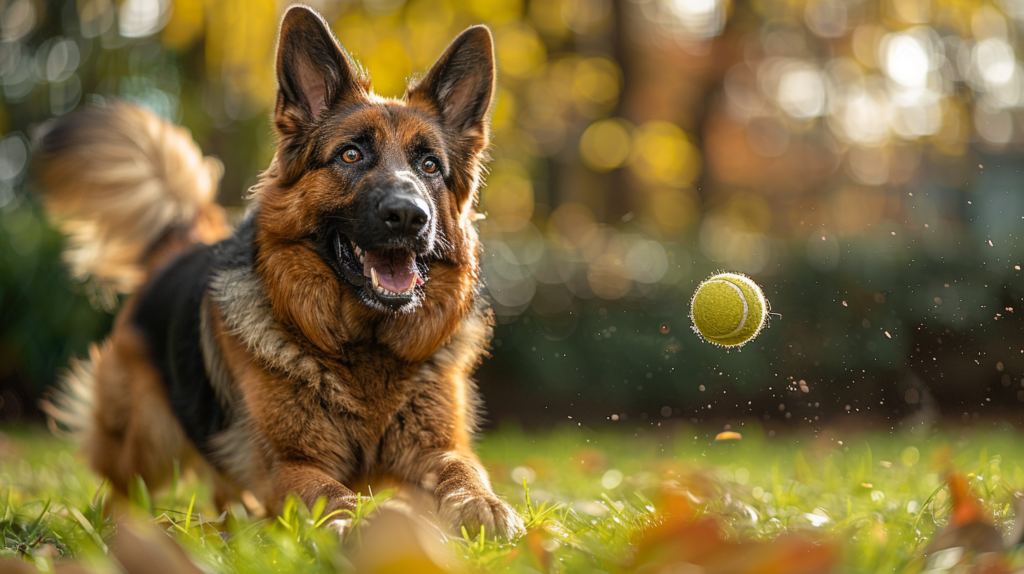
Materials Needed:
- 1 tennis ball (or appropriately sized ball for your dog)
- 1 old sock (knee-high athletic socks work best)
- Scissors (optional)
Time Required:
1-2 minutes
Instructions:
- Create your launcher:
- Place the tennis ball in the toe section of the sock
- Tie a knot in the sock just above the ball to secure it
- The remaining length of sock becomes your handle for throwing
- Using your launcher:
- Hold the open end of the sock
- Swing in a circular motion to build momentum
- Release at the right moment to launch the ball for your dog to chase
- For indoor use, use a gentle swing for shorter distances
Why Dogs Love It:
This simple device transforms a regular game of fetch into an exciting, unpredictable adventure. The sock launcher allows you to throw the ball farther with less arm strain, providing greater physical exercise for energetic dogs.
A 2022 study from the University of British Columbia found that dogs who engage in fetch for at least 15 minutes daily showed significantly lower rates of destructive behavior at home.
Variations:
- Water version: Use a floating ball for water retrieval games
- Multiple balls: Create several launchers with different colored socks to help your dog learn color discrimination
- Treat surprise: Cut a small slit in the tennis ball to insert treats that dispense during play
- Scent games: Use the launcher to toss the ball into tall grass or leaves for added sensory hunting challenge
Expert Tip:
Canine physical therapist Megan Wilson advises: “For older dogs or those with joint issues, use this launcher for shorter, controlled throws that provide mental stimulation without excessive jumping or running. It’s all about adapting the activity to your dog’s physical capabilities.”
Rotating Toy System: Keeping the Interest Alive
One little-known secret among professional dog trainers is the concept of toy rotation. Rather than leaving all toys available at all times, create a system where you cycle through different DIY dog toys every few days.
According to a study published in Animal Cognition, dogs show significantly more interest in toys they haven’t seen for several days compared to those that are constantly available. Dr. Alexandra Horowitz, author of “Inside of a Dog,” explains: “Dogs, like humans, habituate to stimuli in their environment. Simply putting a toy away for a week can make it seem ‘new’ again when reintroduced.”
Consider creating three separate collections of your DIY dog toys and rotating them weekly. This simple practice can dramatically extend the useful life and engagement value of each creation.
Customizing DIY Toys for Your Dog’s Personality
Different dogs have different play preferences. Understanding your pet’s personality can help you create toys they’ll genuinely enjoy:
For the Problem Solver:
- More complex versions of the muffin tin puzzle
- Treat-dispensing bottle toys
- Multi-textured tug toys with hidden features
For the Destroyer:
- Super-durable braided fleece with multiple knots
- Double-layered t-shirt ropes
- Reinforced sock toys
For the Fetcher:
- Lightweight sock ball launchers
- T-shirt balls designed for good bounce
- Fleece frisbees (flattened fleece toys with aerodynamic design)
For the Comfort Seeker:
- Soft fleece toys with minimal stuffing
- T-shirt ropes made from well-worn, familiar clothing
- Crinkle toys with softer sounds
The Importance of Play for Canine Health
Creating DIY dog toys isn’t just about saving money—it’s about supporting your dog’s overall wellbeing. According to the Veterinary Centers of America (VCA), regular play provides numerous health benefits:
- Physical exercise that maintains healthy weight and cardiovascular function
- Mental stimulation that prevents cognitive decline, especially in senior dogs
- Stress reduction through the release of mood-enhancing hormones
- Dental health through appropriate chewing activities
- Behavior management by redirecting energy that might otherwise become destructive
Dr. Julia Jenkins, veterinary behaviorist, notes: “Dogs who have regular access to appropriate toys—especially those that engage different senses and play drives—typically display fewer behavioral problems like excessive barking, digging, or chewing household items.”
By investing just 10 minutes to create these DIY dog toys, you’re contributing significantly to your pet’s quality of life and potentially saving yourself hours of dealing with unwanted behaviors.
When to Replace Your DIY Dog Toys
Even the most carefully crafted homemade toys will eventually wear out. Watch for these signs that it’s time to retire and replace your DIY dog toys:
- Fraying or unraveling that could lead to ingestion of strings or fabric
- Torn fabric exposing inner materials
- Cracked or splintered plastic components
- Compressed or misshapen stuffing
- Unpleasant odors that don’t wash out
- Visible dirt or grime that persists after washing
- Discoloration or mold growth
- Your dog losing interest in a previously favored toy
Most DIY dog toys can be washed in your washing machine using pet-safe detergent. Place smaller items in a pillowcase or delicates bag and use the gentle cycle with cold water.
For more expert pet care tips and product recommendations, visit BlithePet.com — your trusted source for pet wellness.
FAQs About DIY Dog Toys
Q: Are homemade dog toys safe for all breeds?
A: While DIY toys can be safe for most dogs, you should always consider your specific dog’s chewing style, size, and play habits. Power chewers or large breeds may need more durable materials or closer supervision with homemade toys. Always monitor your dog with any new toy initially.
Q: How can I clean DIY dog toys?
A: Most fabric-based DIY toys can be machine washed in cold water with pet-safe detergent. Allow them to air dry completely before returning them to your dog. For plastic-based toys like the water bottle crinkle toy, replace the plastic component regularly for hygiene purposes.
Q: My dog destroys every toy within minutes. What DIY options might last longer?
A: For extreme chewers, focus on densely braided t-shirt or fleece toys with multiple knots throughout. Use thicker materials and consider “double-layering” your designs for added durability. Remember that no toy is truly indestructible—supervision is key for persistent chewers.
Q: Can I use these DIY toys for puppies who are teething?
A: Yes, with modifications. For teething puppies, consider freezing damp fleece toys or creating ice-filled variants of the water bottle toy (supervised only). The cold helps soothe sore gums. Ensure all materials are extra secure as puppies often have sharp teeth but undeveloped chewing control.
Q: How do I know if my DIY materials are safe?
A: Stick to natural, non-toxic materials like 100% cotton t-shirts, pure fleece without chemical treatments, and thoroughly cleaned plastic containers. Avoid buttons, zippers, or decorative elements that could be chewed off and swallowed. When in doubt, consult your veterinarian about specific materials.
Q: Can making DIY toys help with separation anxiety?
A: Yes, interactive toys that dispense treats or provide complex challenges can help distract dogs with mild separation anxiety. Consider creating puzzle toys using your scent (like t-shirt material you’ve worn) to provide comfort. However, severe separation anxiety requires professional behavioral intervention in addition to enrichment toys.
Conclusion:
The Joy of Crafting for Your Canine
Creating DIY dog toys offers far more than just cost savings—it provides an opportunity to connect with your pet through thoughtfully crafted playthings tailored to their specific needs and preferences. The simple act of transforming everyday household items into engaging toys demonstrates your care and attention in a way your dog can directly appreciate.
Whether you’re crafting a simple t-shirt rope for tugging games or designing a complex treat puzzle for mental stimulation, these 10-minute projects deliver impressive returns in terms of your dog’s happiness and wellbeing. The environmental benefits of upcycling materials and reducing consumer waste are valuable bonuses to the primary reward: watching your furry friend enjoy your creations.
Remember that the best toy collection includes variety—items for chewing, tugging, fetching, and problem-solving—to engage all aspects of your dog’s natural play drives. By rotating toys regularly and replacing them when they show signs of wear, you’ll maintain your pet’s interest while ensuring their safety.
We hope this guide has inspired you to get creative with DIY dog toys that will delight your canine companion for hours of healthy play. With just basic household materials and a few minutes of your time, you can become your dog’s favorite toy designer!
Have a similar experience with your pet? Share it in the comments below!

